Abstract
Context:
Cheiloscopy and dactyloscopy, both are well-established forensic tools used in individual identification in any scenario be it a crime scene or civil cause. Like finger prints, lip prints are unique and distinguishable for every individual. But their relationship to personality types has not been established excepting the hypothesis stating that finger prints could explain these personality patterns.
Aims:
The study was aimed to record and correlate the lip and finger prints with that of character/personality of a person.
Settings and Design:
The lip and finger prints and character of a person were recorded and the data obtained was subjected for statistical analysis, especially for Pearson's Chi-square test and correlation/association between the groups was also studied.
Materials and Methods:
The study sample comprised of 200 subjects, 100 males and 100 females, aged between 18 and 30 years. For recording lip prints, brown/pink-colored lipstick was applied on the lips and the subjects were asked to spread uniformly over the lips. Lip prints were traced in the normal rest position on a plain white bond paper. For recording the finger prints, imprints of the fingers were taken on a plain white bond paper using ink pad. The collected prints were visualized using magnifying lens. To record the character of person, a pro forma manual for multivariable personality inventory by Dr. BC Muthayya was used.
Statistical Analysis Used:
Data obtained was subjected for statistical analysis, especially for Pearson's Chi-square test and correlation/association between the groups was also studied.
Results:
In males, predominant lip pattern recorded was Type I with whorls-type finger pattern and the character being ego ideal, pessimism, introvert, and dogmatic; whereas in females, predominant lip pattern recorded was Type II with loops-type finger pattern and the character being neurotic, need achievers, and dominant.
Conclusion:
Many studies on lip pattern, finger pattern, palatal rugae, etc., for individual identification and gender determination exist, but correlative studies are scanty. This is the first study done on correlating patterns, that is, lip and finger pattern with the character of a person. With this study we conclude that this correlation can be used as an adjunct in the investigatory process in forensic sciences.
Keywords: Character, cheiloscopy, dactyloscopy, forensic science, personality
Introduction
The wrinkles and grooves on the labial mucosa called as sulci labiorum forms a characteristic pattern called as lip print and study of these lip prints is called as cheiloscopy.[1,2,3] Lip prints are unique to an individual and does not change during the lifetime of an individual.[4,5] Likewise, fingerprints are an impression of the friction ridges of all part of the finger. A friction ridge is a raised portion of the epidermis on the digits or on the palmar and plantar skin, consisting of one or more connected ridge units of friction ridge skin.[6] Study of finger print is called as dermatoglyphics.[3] This finger print, like the lip print, is unique to an individual and stable throughout the lifespan.[6]
Personality/character of an individual can be defined as the patterns of behavior, thought, and emotion unique to an individual, and the ways they interact to help or hinder the adjustment of a person to other people and situations.[7] Scientific studies correlating the finger prints to the personality/character of a person has helped to understand the personality of an individual whether he/she is an extrovert or introvert or both based on the direction of flow of psychological energy, which the scientist say can be known from the direction of the frictional ridges.[8,9] If it is in outward direction then the person is said to be extrovert, if it is in inward then introvert, and if both are present then the person has mixed personality.[10]
Numerous scientific studies have been carried out correlating the finger print with that of character of a person, but there exist no study correlating lip print with character of person. Few studies exists correlating lip print with finger pattern[3] and there are no studies correlating these parameters with personality/character of an individual. So the present study was done to record the lip and finger pattern with the character of a person; to elucidate unique combination of lip and finger pattern existence; and to know whether this bears any relation to the individual's character.
Materials and Methods
The present study has been reviewed by the institutional ethical committee and has therefore been performed in accordance with the ethical standards laid down in the 1965 Declaration of Helsinki. A total of 100 males and 100 females in the age group of 18–30 years were selected randomly for the study after obtaining informed consent. Individuals free from any pathology of the lips or fingers were included in the study. Individual with known hypersensitivity and mentally challenged individuals were excluded from the study.
Materials used in the study were dark brown/pink-colored lipstick, plain white bond paper, blue inked stamp pad, magnifying lens, and pro forma manual for multivariable personality inventory by Dr. BC Muthayya.
For recording the lip print, the subjects were asked to rinse the mouth with water and the lips were allowed to dry. Then the pink lipstick was applied on the lips and the subjects were asked to spread it uniformly over the lips by gentle movement of the lips. After 2 min a lip impression was made on a plain white bond paper by asking the subjects to press on the lips onto the paper. This served as a permanent record. While studying the lip prints, each subject's lips were divided into four quadrants and were allotted the digits 1–4 in a clockwise sequence starting from subjects' upper right followed by upper left, lower left, and ending at lower right. For examination of lip print, middle third of the upper and lower lip was taken as study area at this part is more prominent and visible in any trace that has been made [Figure 1].[2,11]
Figure 1.
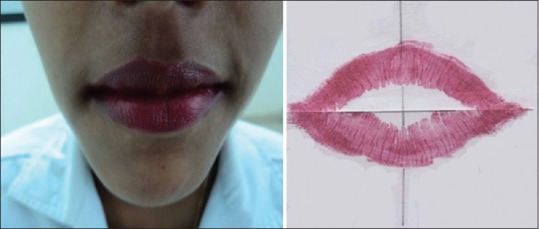
Lip print record
Analysis of lip prints
In the present study, lip prints were classified using the classification proposed by Suzuki and Tsuchihashi, also known as Tsuchihashi classification.[12,13,14,15]
Type I - Vertical pattern, comprising of complete (end to end) longitudinal fissures/patterns
Type I' - Incomplete longitudinal fissures
Type II - Branching Y-shaped pattern
Type III - Crisscross pattern
Type IV - Reticular pattern, typical checkered pattern, fence like.
Finger print recording was done by asking the subjects to ink all their finger pads, both right and left hands, and the impression was recorded on a white bond paper. Then the finger pattern was studied with the help of magnifying lens and the predominant pattern of 10 finger pads (in each subject) is taken into consideration [Figure 2].
Figure 2.

Finger print record
Analysis of finger prints
In the present study, Henry's classification of finger prints was followed:[6,16]
Arch pattern: Plain, radial, ulnar, tented
Loop pattern: Radial, ulnar
Whorl pattern: Plain, central pocket, double loop, accidental.
Analysis of personality/character
Assessment of personality/character of a person was done with the help of Multivariable Personality Inventory Method proposed by Dr. BC Muthayya.[17] In this the subjects were given the inventory questionnaire and asked to answer in yes/no in their first reaction and not a long drawn thought process. Then the analysis was done with help of the scoring key of the manual, based on the scores obtained and respective personality was assigned to the individual subjects. With the help of information available in literature relevant to the subject, nine personality variables were selected, viz., empathy, ego ideal, pessimism, introversion, neuroticism, need-achievement, self-confidence, dogmatism, and dominance.[17]
The data obtained was subjected to statistical analysis using Pearson's Chi-square test. P ≤ 0.05 is considered as statistically significant. And also correlation/association between the study groups was also studied where r ≤ 1 is considered as significant association.
Results
The present study revealed that the overall predominant lip pattern among all the study subjects was found to be Type I and least common to be Type IV. Among males it was found that Type I (74%) was the most predominant lip pattern; whereas, Type II (70%) was the most predominant lip pattern in females [Figure 3]. The lip print pattern revealed statistically significant results within the gender (P < 0.0001) [Table 1].
Figure 3.
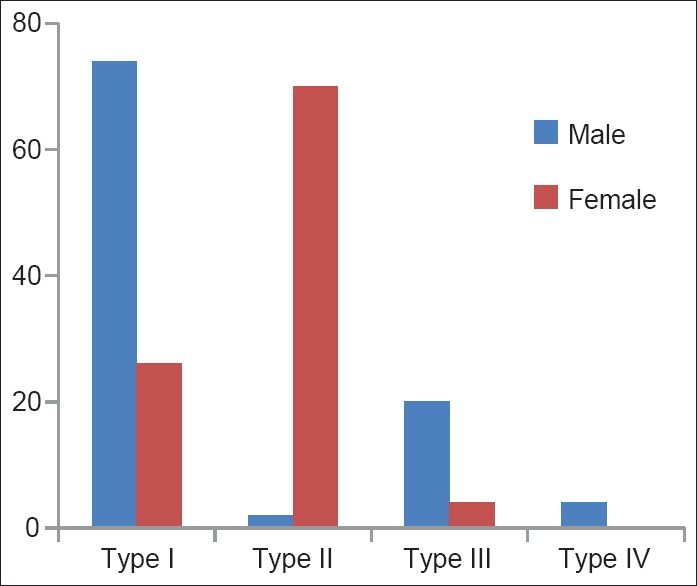
Association between gender and lip pattern
Table 1.
Tabular distribution of lip pattern and finger pattern in males and females
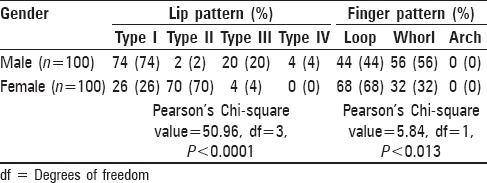
The study of the finger print revealed that the overall predominant pattern among all the study subjects was found to be loop pattern followed by whorl pattern. Among males it was found that whorl pattern (56%) was the most predominant finger pattern; whereas, loop pattern (68%) was the most predominant finger pattern in females [Figure 4]. The finger print pattern revealed statistically significant results within the gender (P < 0.013) [Table 1].
Figure 4.
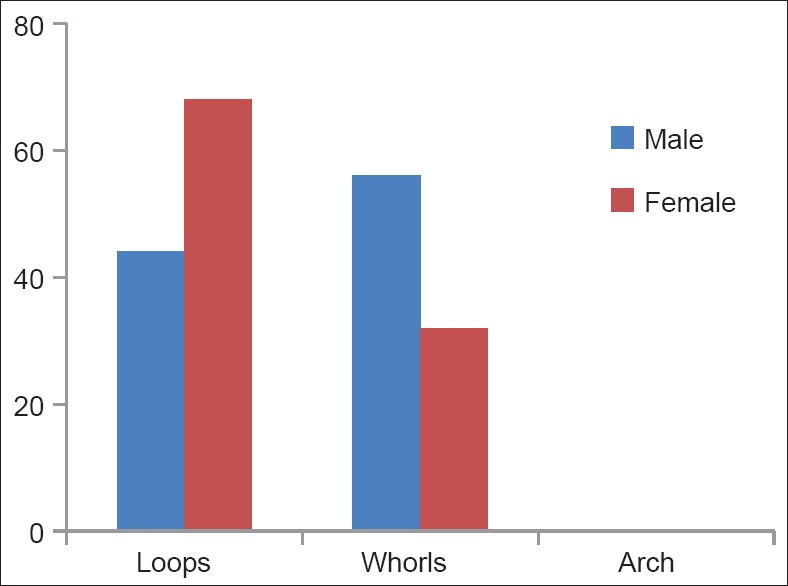
Association between gender and finger print pattern
Personality/character among males and females
The study of the personality/character among the subjects revealed that all the subjects in the study group were empathy; males were ego ideal, pessimistic, introvert, and dogmatic type; whereas, females were neurotic, need achiever, and dominant type [Figure 5]. The personality/character revealed statistically significant results within the gender (P ≤ 0.05) [Table 2].
Figure 5.
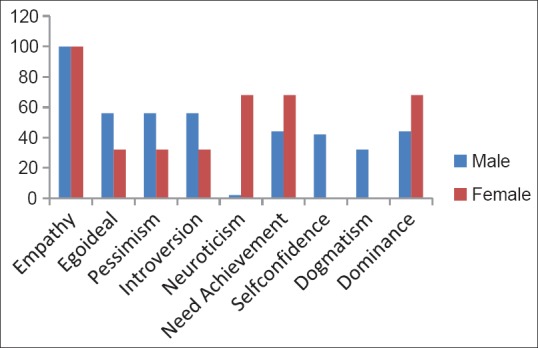
Association between gender and personality/character
Table 2.
Tabular distribution of personality/character among males and females

The present study showed that in males predominant lip pattern recorded was Type I with whorl-type finger pattern and the character being ego ideal, pessimism, introvert, dogmatic; whereas, in females predominant lip pattern recorded was type II with loop type finger pattern and the character being neurotic, need achievers, and dominant.
The overall correlation/association of lip prints with that of the personality/character was also studied which is given in Table 3 for males and Table 4 for females. In males, Type I, III, and IV lip pattern showed good correlation/association with the character/personality of the individual [Table 3]. In females, Type I and II lip pattern showed good correlation/association with the character/personality of the individual [Table 4].
Table 3.
Correlation of lip patterns with character in males (n=100)

Table 4.
Correlation of lip patterns with character in females (n=100)

The overall correlation/association of finger pattern with that of the personality/character was also studied and is given in Table 5 for males and Table 6 for females. In males and females, loop and whorl finger pattern showed good correlation/association with the character/personality of the individual [Tables 5 and 6].
Table 5.
Correlation of finger patterns with character in males (n=100)

Table 6.
Correlation of finger patterns with character in females (n=100)

Discussion
Historically, human identification is one of the most challenging subjects that man has confronted and the concept of “identity” is a set of physical characteristics, functional or psychic, normal or pathological that defines an individual.[15] Traditionally for personal identification, methods like anthropometry, finger printing, age estimation, height, and blood groups were used.[4] Nowadays, human identification is a universal process based on scientific principles, mainly involving the antemortem records and postmortem reports. Of late, DNA finger printing and DNA extraction from different specimens is in rogues, the objective of which is to identify and register individual for both civil and criminal identification purposes. Just like all these methods, lip prints can also be instrumental in identifying a person positively and can be used to verify the presence or absence of a person. A lip print at the scene of crime can be basis for conclusion as to the character of the event, number and sex of the people involved, cosmetics used, habits, occupational trials, and the pathological changes of the lips themselves.
Finger print is an impression of the frictional ridges of a part or all part of the fingers and study of which is called as dactyloscopy/dermatoglyphics. Finger patterns are genetically determined and remain unchanged till death.[6] Assessing or analyzing personality of person can be useful in investigatory procedures as it can narrow down the search for the suspect. This assessment/analyzing can be done taking the help of the finger print pattern of the individuals as there are scientific studies that have proved that a person, extrovert or introvert or both, can be judged based on the direction of flow of psychological energy which the scientist say can be known from the direction of the frictional ridges.[9,10]
Due to the immense potential of lip and finger prints as effective method of identification, the present study was undertaken to elucidate the combined and/or individual role if any in determining the character of a person which is first of its kind in literature to the best of our knowledge.
Lip pattern of 200 subjects (100 males and 100 females) were recorded and analyzed and it was found that the most predominant lip pattern in males was Type I (complete and incomplete vertical) and Type II in females (Y branching). Similar findings were observed by Patil et al., in their study on lip prints where they found that Type I in males and Type II in females was the predominant lip patterns.[18]
Contradictory to the present study findings, studies done by Tsuchihashi observed Type III lip pattern predominantly in both males and females.[13] Vahanwala and Parekh noted that in females all four quadrants have same type of lip pattern, but males had different patterns.[14] Vahanwala et al., recorded Type I and I' pattern predominantly in females; and in males it was Type III and IV.[15] Sivapathasundaram et al., observed that type III was the predominant lip pattern in males and females.[11] Chaitanya Babu et al., observed Type I and II patterns predominantly in females and Type III and IV in males.[2] Gondivkar et al., observed Type III lip pattern predominantly in males and Type II in females.[4] Saraswathi et al., observed intersected type of lip pattern predominantly in both males and females.[5] Verghese et al., recorded Type III pattern predominantly in both males and females.[12] Sharma et al., observed that in males the most prominent lip pattern was Type IV and Type II in females.[1] The previous work on the subject of lip pattern shows that different racial and ethnic groups show difference in the predominant lip print pattern.
Analyzing the finger pattern, the present study demonstrated whorls finger pattern predominant in males and in females loops are more predominant type of finger print pattern. Similar findings were observed in studies carried out by various authors: Nitin et al.,[19] Campbell,[8] Reddy,[20] Rastogi and Pillai,[6] Ekanem et al.,[21] and Reddy and Reddy.[22] They recorded whorl finger pattern predominantly in males and loop type in females.
Assessing the character/personality of an individual helps to know the nature, attitude, mentality, social well-being, capabilities, and shortcomings of an individual. It was hypothesized by the Russian biometrist, Viktor Minkin, that there exist a direct link between finger prints, which reflects the character and health of the person and DNA that can be explained via the thermodynamics of human development.[9,10] Based on this hypothesis the present study was carried out to elucidate the combined and/or individual role of lip and/or finger pattern if any in determining the character of a person.
There are various methods to determine the character of an individual: a) Eysenck's Personality Inventory, b) Bernreuter's Personality Inventory, c) Miller's, d) Multivariable Personality Inventory, and e) Minnesota Personality Inventory. In the present study, Multivariable Personality Inventory method proposed by Dr. BC Muthayya was used for analyzing the personality/character of the individuals. Nine personality variables were selected-empathy, ego ideal, pessimism, introversion, neuroticism, needs achievement, self-confidence, dogmatism, and dominance.[17] A brief description of these variables is as follows:
Empathy
It is also known as interpersonal sensitivity and has been considered for people in leadership positions. This involves the realization and understanding of another person's feelings, needs, and sufferings.
Ego ideal
It is composed of all the fantasies which portray the person as hero, accomplishing great deeds or achieving recognition. Taken together, at any stage of a person's life, they represent his highest hope, the dramatization of himself as a man of destiny. Failure to actualize his instituted fantasy depresses him.
Pessimism
It is a tendency to look upon the failure with uncertainty, disbelief or disdain accompanied, sometimes, by expectations of negative happenings regardless of the actualities of the situation.
Introversion
This introvert tends to be self-oriented. The interests of the individual runs toward the intellectual and artistic, and shows more concern for abstract ideas than reality.
Neuroticism
This implies a heightened sensitivity to stressful environmental situations; a low degree of stress tolerance.
Needs achievement
This implies a desire or tendency to complete a standard of excellence where; winning or doing well is the primary concern, affective concern over one's goal attainment, and there is no competition with others, but involves meeting a self-imposed requirement of a good response.
Self-confidence
It is an important variable as it indicates the extent of assurance one possess about one's capacities and abilities; and is not only confronting problem situations, but also in finding solution to them.
Dogmatism
It is a closed way thinking which could be associated with any ideology regardless content: An authoritarian outlook on life, intolerance towards those with opposing beliefs, and a sufferance of those with similar beliefs.
Dominance
Individuals whose personalities are characterized by dominance or ascendance will more frequently be found to occupy or emerge in leadership roles. Some of the behavioral components of this variable are to control one's human environment and to influence or direct the behavior of others by suggestion, reduction, persuasion, or command.
With the help of Multivariable Personality Inventory method proposed by Dr. BC Muthayya, the present study revealed that all the subjects in the study were empathy, while males possessed predominantly ego ideal, pessimism, introvert, dogmatic character; females were neurotic, need achievers, and dominant type.
Correlating the lip pattern and character of the subjects, the present study recorded that in males Type I lip pattern showed strong association with the characters—ego ideal, pessimism, introvert, and dogmatism; followed by Type III lip pattern in association with the characters—need achievers, self-confidence, and dominance; and Type IV in association with the characters—need achievers, self-confidence, and dominance (r = 0.707). In females Type II lip pattern showed strong association with the characters—neurotic, need achievers, and dominance; followed by Type I lip pattern in association with the characters—ego ideal, pessimism, and introvertism (r = 0.707).
Correlating the finger pattern and character of the subjects, the present study recorded that in males whorl finger pattern showed strong association with the characters—ego ideal, pessimism, introvert, and dogmatism; followed by loops finger pattern in association with the characters—need achievers, self-confidence, and dominance (r = 0.707). In females loops finger pattern showed strong association with the character—neurotic, need achievers, and dominance; followed by whorl pattern in association with the characters—ego ideal, pessimism, and introvertism (r = 0.707).
The present study is the first comparative study between lip prints and the character of an individual; and between finger patterns and the character of an individual. Our results showed that predominant lip prints and finger patterns in males and females can suggest the personality/character of an individual which can be an adjunct in forensic scenario.
Conclusion
There are many studies on lip prints, finger patterns, character, etc., but correlative studies are scanty. This study is first of its kind performed correlating two patterns with that of character of an individual which showed good amount of association between the study groups. The present study was performed with a holistic approach relating these parameters and intended to utilize these unique parameters in investigation procedures reconstructing the events step by step and joining one link to the other that could give a clue about the suspects in criminal investigation procedures. These things will surely instigate the brain of investigator to look for persons who show these characters and the search can revolve around them, narrowing down the search for suspect. It is like step by step approach towards the criminal and finally the most important the “truth”. The future prospective of this study is that lip prints, finger prints, and personality of a person should be studied in depth with larger sample size in both sexes to establish further facts and truths which will help in forensic sciences.
Footnotes
Source of Support: Nil
Conflict of Interest: None declared
References
- 1.Sharma P, Saxena S, Rathrod V. Cheiloscopy: The study of lip prints in sex identification. J Forensic Dent Sci. 2009;1:24–7. [Google Scholar]
- 2.Chaitanya BN, Premalatha BR, Jude J. Cheiloscopy: A new aid for sex identification in forensic science. Indian J Forensic Odontol. 2009;2:131–6. [Google Scholar]
- 3.Nagasupriya A, Dhanpal R, Reena K, Saraswathi T, Ramandran C. Pattern -"A crime solver". J Forensic Dent Sci. 2011;3:3–7. doi: 10.4103/0975-1475.85282. [DOI] [PMC free article] [PubMed] [Google Scholar]
- 4.Gondivakr SM, Indurkar A, Degwekar S, Bhowate R. Cheiloscopy for sex determination. J Forensic Dent Sci. 2009;1:56–60. [Google Scholar]
- 5.Saraswathi TR, Mishra G, Ranganathan K. Study of Lip Prints. J Forensic Dent Sci. 2009;1:28–31. [Google Scholar]
- 6.Rastogi P, Pillai KR. A study of finger prints in relation to gender and blood groups. J Indian Acad Forensic Med. 2010;32:11–4. [Google Scholar]
- 7.Personality. Encyclopedia. [Last accessed on 2013 Apr 30]. Available from: http://encyclopedia2.thefreedictionary.com/Personality .
- 8.Edward D. Campbell. A history of dermatoglyphics, palmistry and character identity. [Last accessed on 2012 May]. Available from: http://www.handanalysis.co.uk .
- 9.Minkin V. Fingerprints and the thermodynamics of human development. J Hum Thermodyn. 2008;4:8–12. [Google Scholar]
- 10.Jung CG, Baynes HG. Collected Works. Vol. 6. London: Kegan Paul Trench Trubner; 1921. Psychological types or the psychology of individuation. ISBN 0-691-01813-8. [Google Scholar]
- 11.Sivapathasundaram B, Prakash PA, Sivakumar G. Lip Prints (cheiloscopy) Indian J Dent Res. 2001;12:234–7. [PubMed] [Google Scholar]
- 12.Verghese AJ, Somasekar M, Umesh BR. A study of lip prints in people of Kerala. J Indian Acad Forensic Med. 2009;32:6–8. [Google Scholar]
- 13.Tsuchihashi Y. Studies of person identification by means of lip prints. Forensic Sci. 1974;3:233–48. doi: 10.1016/0300-9432(74)90034-x. [DOI] [PubMed] [Google Scholar]
- 14.Vahanwala SP, Parekh BK. Study of lip prints as an aid to forensic methodology. J Forensic Med Toxicol. 2000;17:12–8. [Google Scholar]
- 15.Vahanwala S, Nayak CD, Pagare SS. Study of lip print as an aid for sex determination. Medico-Legal Update. 2005;5:93–8. [Google Scholar]
- 16.Henry ER. Classification and uses of finger prints. London: George Routledge and Sons; 1900. [Google Scholar]
- 17.Muthayya BC. Manual for Multivariable personality inventory (MPI) Agra: Agra Psychological Research Cell; 1973. [Google Scholar]
- 18.Patil S, Paul I, Madhusudan AS, Gayathri R, Sowmya GV. A study of lip prints in relation to gender, family and blood group. Int J Oral Max Path. 2010;1:4–7. [Google Scholar]
- 19.Nitin MD, Balraj BM, Manjunath B, Mestri SC. Study of finger print classification and their gender distribution among South Indian population. J Forensic Leg Med. 2009;16:460–3. doi: 10.1016/j.jflm.2009.07.001. [DOI] [PubMed] [Google Scholar]
- 20.Reddy GG. Finger dermatoglyphics of the Bagathas of Araku valley (A.P) Indian J Phys Anthropol. 1975;42:225–8. doi: 10.1002/ajpa.1330420208. [DOI] [PubMed] [Google Scholar]
- 21.Ekanem EP, Eluwa MA, Udoaffah GU, Ekanem TB, Akpantah AO. Digital dermatophylics pattern of annang ethic group in akwa ibom state of Nigeria. Internet J Bio Anthropol. 2009:3. [Google Scholar]
- 22.Reddy BM, Reddy CP. Population structure and pattern of Dermatoglyphics variation in Andhra Pradesh, India. IJHG. 2001;1:203–9. [Google Scholar]


